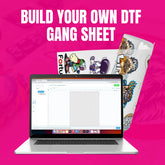What is the Future of DTF Printing Technology?
What is DTF? This word is increasingly difficult to overlook if you're investigating the realm of clothing printing or just interested in how designs find their way onto t-shirts and bags. Direct-to-film printing, or DTF, is altering consumer behavior toward custom prints. DTF has evolved from a niche solution to a growing star in the printing sector over the last several years. Its strength resides in simplicity, economy, and speedy production of excellent outcomes. The future of DTF printing technology will be discussed in this article, and the most recent developments advancing this field will be explained.
What Is Driving The Growing Popularity Of DTF Printing?
Knowing why DTF attracts so much interest will help us predict the future. DTF is acting differently here? It eliminates the need for screens, vinyl, or costly setup first. You can print one shirt or a thousand with the same quality and little overhead. It's versatile, simple to master, and produces vivid, bright colors even on dark clothes. DTF heat transfers stick to cotton, polyester, mixes, denim, canvas, and more. Small companies, hobbyists, and even major corporations find this adaptability intriguing.
Here are actual statistics to demonstrate its expansion: current industry data indicates that the demand for DTF printing has increased by more than 40% throughout North America over the previous two years. That climb is based on dependability and creativity; it is not random.
How Are DTF Printing Machines Evolving?
The machinery itself represents one of the main advances in DTF printing. Early iterations had a learning curve, manual alignment, and regular cleaning needed. But DTF printing machines are far faster and wiser now. Epson and Roland are entering the market with equipment designed especially for DTF. These devices simplify maintenance, provide automatic calibration, and have higher ink flow. As such, More constant quality and less downtime.
Today, automated systems used in high-volume print factories print over 400 DTF transfer sheets each hour. A few years ago, that kind of size seemed unreal. The machines are more dependable than simply faster; dependability translates into more profit and less waste.
Are There Changes In The Materials Used For DTF?
Yes. If not a mix of clever chemistry and printing precision, what is DTF? The ink, powder, and film all affect the DTF heat transfer quality. Older powders crack or peel after a few washings. Premium hot melt powders of today produce improved flexibility, durability, and adhesion. Movies are also improving—they are more transparent, double-sided, and made for hot peel techniques, thereby smoothing out the whole process.
DTF Transfer Art claims their current transfers resist 50+ washes without appreciable fading or cracking. People trust this approach primarily for its durability. Reduced unsuccessful prints resulting from better powders and films also save time and money.
Can Automation Reshape The Future Of DTF?
DTF is already being done differently by automation. From conveyor systems to auto heat presses, significant operations employ intelligent machines capable of applying the transfers in addition to printing. Pressing hundreds of shirts in a single shift with little human involvement, these heat presses retain ideal temperatures and pressure.
Initially only employed in screen printing, this arrangement is increasingly catching on with DTF. The best thing is that you do not have to be a large-scale automated factory. Modest studios may now afford modest DTF printing machines with semi-automated features to enable quick scaling.
Will DTF Printing Replace Other Methods?
Among the most often asked questions is what DTF is doing that can cause DTG or screen printing to be pushed out. It's widening the field rather than substituting for them. For large batches of basic patterns, screen printing is still quite excellent. DTF transfer sheets excel; nevertheless, in full-color, short-run tasks require plenty of detail.
DTF's adaptability is already causing brands to migrate away from direct-to-garment printing. Unlike DTG, DTF eliminates white ink management and pretreatment. Instead, you get a ready-to-use sheet that will keep for months and be pressed as needed. It's faster, simpler, and makes sense for many occupations.
How Is Customization Getting Easier With DTF?
One of the most interesting components of DTF's future is mass customisation. Want every shirt to have a distinct name? No issue. Would like to try several color variations of a design? Simplicity. DTF gang sheets save space and money by letting customers mix multiple tiny graphics into one print run.
At DTF Transfer Art, the gang sheet creator lets you personalize whole batches online in minutes. You can post your design, select a scale, and create a batch fit for your project. This personalization was required hours ago; today, it takes minutes.
What Should Users Expect From DTF In The Next Few Years?
The easy answer to your question about what DTF will look like in a few years is faster, smarter, and even more accessible. Manufacturers are stressing consistency—better color profiles, reduced maintenance, and simplified processes. As expenses drop and quality increases, DTF will be used not only by professionals but also by students, artists, and regular users.
Another significant change is the spread into new markets. DTF is entering signage, soft furniture, and promotional items, but clothes are still the primary use. DTF will be there anywhere a vivid, long-lasting print is required. Another statistic is that demand from custom fashion, and e-commerce companies drive market predictions that the DTF sector will surpass $1 billion worldwide by 2027.
Conclusion
What is DTF actually giving for the direction of printing? Whether you're printing for fun or a business, it's giving everyone speed, inventiveness, and quality. The difference between small artists and big manufacturers is narrowing rapidly as DTF printing equipment becomes more sophisticated and the materials improve. It is about improved prints and more straightforward procedures, clever tools, and more personalizing possibilities going forward.
If you want to explore this fast-moving technology more deeply, check out DTF Transfer Art for resources, tools, and support that match today's pace.
- Blended fabrics for DTF
- bulk dtf transfers
- bulk printing
- cost-efficient printing
- Cotton for DTF
- Custom apparel
- custom apparel printing
- Custom clothing printing
- custom gangsheet
- Custom gangsheet DTF transfer sheets
- Custom gangsheet printing
- Custom Gangsheets
- custom heat transfers
- Custom iron patches
- custom prints
- decal production
- decal transfer
- decal transfers
- Design preparation
- Digital printing
- Direct-to-Film Transfer
- dtf business
- DTF gangsheet
- DTF Heat Press
- dtf print shop
- DTF printer supplier
- DTF Printing
- dtf transfer
- dtf transfer art
- dtf transfer film
- dtf transfer instructions
- dtf transfer paper
- DTF transfer paper suppliers
- dtf transfer printer
- dtf transfer sheets
- DTF transfer supplier
- DTF transfer wholesale
- dtf transfers
- dtf transfers near me
- dtf transfers ready to press
- dtf transfers wholesale
- DTF vs Screen Printing
- DTF vs Vinyl
- DTF vs. iron-on
- dtf wholesale
- gangsheet printing
- heat press printing
- Heat press settings
- Heat settings for DTF
- heat transfer decals
- heat transfer method
- heat transfer printing
- Heat transfers
- hoodie printing
- Hoodies
- hot peel DTF
- iron-on decals
- Leather DTF transfers
- Local print shops
- Luxury bags
- Mild detergent for DTF prints
- model decals
- Nylon DTF transfer
- Peeling or cracking prevention
- Polyester for DTF
- premium DTF transfers
- print on demand
- Print shops near me
- Printed designs durability
- Printing companies
- Printing methods
- Quality printing
- reliable DTF transfer printer supplier
- Screen printing
- Spandex DTF transfer
- sticker printing
- Stretch fabrics DTF
- Sublimation printing
- t shirt printing
- T-shirts
- Textile printing
- Tote bags
- Transfer printing
- trustworthy DTF transfer supplier
- vinyl decals
- Washing care for DTF prints
- what is dtf transfer






